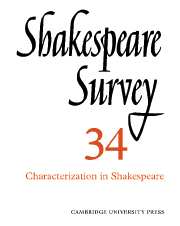Book contents
- Frontmatter
- Shakespeare’s Open Secret
- The Emergence of Character Criticism, 1774–1800
- Society and the Individual in Shakespeare’s Conception of Character
- Realistic Convention and Conventional Realism in Shakespeare
- On Expectation and Surprise: Shakespeare’s Construction of Character
- Shakespeare and the Ventriloquists
- The Rhetoric of Character Construction: Othello
- Characterizing Coriolanus
- The Ironic Reading of The Rape of Lucrece and the Problem of External Evidence
- The Unity of Romeo and Juliet
- No Abuse: The Prince and Falstaff in the Tavern Scenes of Henry IV
- Twelfth Night: The Experience of the Audience
- Plays and Playing in Twelfth Night
- Sceptical Visions: Shakespeare’s Tragedies and Jonson’s Comedies
- Shakespeare in Performance, 1980
- The Year's Contributions to Shakespearian Study 1 Critical Studies
- 2 Shakespeare’s Life, Times and Stage
- 3 Textual Studies
- Index
- Plate Section
Sceptical Visions: Shakespeare’s Tragedies and Jonson’s Comedies
Published online by Cambridge University Press: 28 March 2007
- Frontmatter
- Shakespeare’s Open Secret
- The Emergence of Character Criticism, 1774–1800
- Society and the Individual in Shakespeare’s Conception of Character
- Realistic Convention and Conventional Realism in Shakespeare
- On Expectation and Surprise: Shakespeare’s Construction of Character
- Shakespeare and the Ventriloquists
- The Rhetoric of Character Construction: Othello
- Characterizing Coriolanus
- The Ironic Reading of The Rape of Lucrece and the Problem of External Evidence
- The Unity of Romeo and Juliet
- No Abuse: The Prince and Falstaff in the Tavern Scenes of Henry IV
- Twelfth Night: The Experience of the Audience
- Plays and Playing in Twelfth Night
- Sceptical Visions: Shakespeare’s Tragedies and Jonson’s Comedies
- Shakespeare in Performance, 1980
- The Year's Contributions to Shakespearian Study 1 Critical Studies
- 2 Shakespeare’s Life, Times and Stage
- 3 Textual Studies
- Index
- Plate Section
Summary
Two masters of the stage, writing mostly for the same actors and the same audience, achieving their full artistic powers in the same decade in the greatest age of English drama, would seem to invite, even to demand, simultaneous consideration. But received opinion holds that Shakespeare and Jonson resist comparison, that the search for resemblance is a waste of time. The disposition of authors in the normal university English curriculum reflects the conventional point of view: Shakespeare is given one course, ‘contemporaries of Shakespeare’ another. Modern reluctance to consider their work together is probably a function of the clumsy, tendentious way such comparisons have been conducted in the past. Dryden innocently established the terms of discourse when he confessed that he admired Jonson but loved Shakespeare, and since then, particularly in the first half of this century, Jonson has frequently been called in merely as evidence of the superior artistry and especially the deeper humanity of Shakespeare. The manifest impropriety of this practice seems to have generated a powerful backlash against outright comparison: most critics hesitate to put the two playwrights side by side, and some proclaim openly the perils of doing so.
- Type
- Chapter
- Information
- Shakespeare Survey , pp. 131 - 148Publisher: Cambridge University PressPrint publication year: 1982

